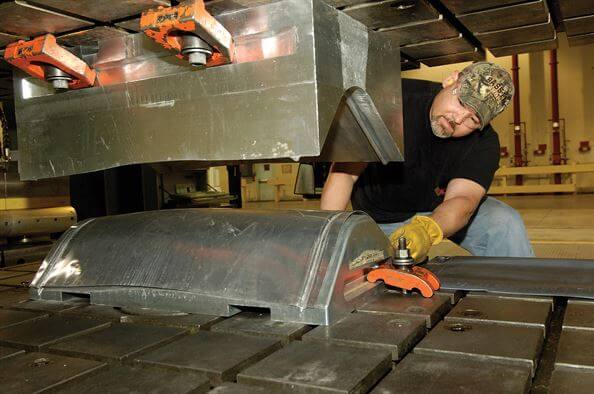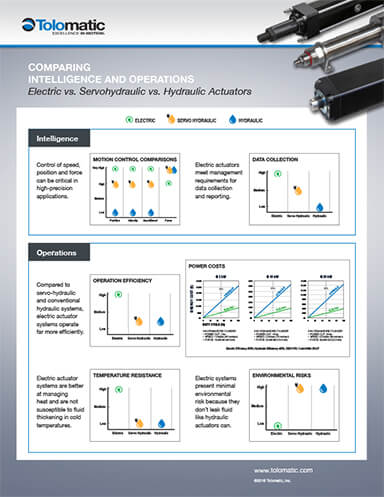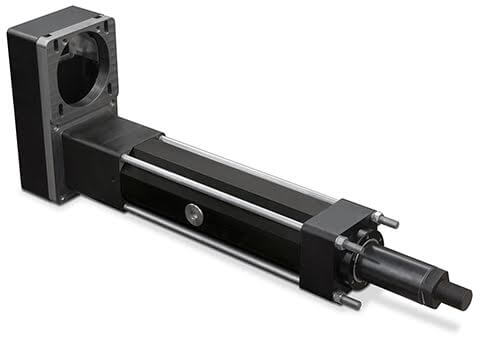High force linear actuators: How to convert from hydraulics to electric
By Tolomatic on November 14, 2017
 For high force linear actuator applications, machine designers often first look to hydraulic cylinders. For good reason, too. Hydraulic cylinders can be a bargain to purchase, delivering high force at a low cost per unit of force. Plus, they’re rugged and well understood. But there’s another technology to consider. Electric linear actuators are available with high force capacities. These actuators are more flexible, precise and reliable than their hydraulic counterparts.
For high force linear actuator applications, machine designers often first look to hydraulic cylinders. For good reason, too. Hydraulic cylinders can be a bargain to purchase, delivering high force at a low cost per unit of force. Plus, they’re rugged and well understood. But there’s another technology to consider. Electric linear actuators are available with high force capacities. These actuators are more flexible, precise and reliable than their hydraulic counterparts.
It’s not unusual to run into hydraulic cylinder applications that would benefit from conversion to electric linear motion control. But how do you make a successful conversion? Get our new white paper for tips on converting from hydraulic cylinders to electric actuators.
Why use electric linear actuators?
When you need high force actuation, consider all factors carefully. While hydraulic actuation systems may be appropriate for simple motion profiles with high force requirements, an electric system can offer many advantages for complex linear motion. As a machine designer, you’ll want to consider all the relevant factors like:
- Force Roller screw-powered electric actuators can deliver forces of over 50,000 lbf (225.5 kN). Force is instantaneous unlike hydraulic cylinders that must wait for pressure to build.
- Control An electric roller screw servo-actuator offers infinite control over critical variables, and adjustments can be made on the fly.

- System footprint An electric linear actuator’s footprint comes to a fraction of the size of a hydraulic cylinder with its hydraulic power unit.
- Sensitivity to temperature Electric actuation systems are temperature-tolerant while hydraulics are sluggish in cold and subject to oil degradation in heat.
If an electric linear actuator is sized correctly for the application, there is no maintenance required and no downtime. For correct electric actuator sizing, rely on sizing software.
- Data collection Sensing capability is built into an electric actuator’s servo system. Standard hydraulic actuation systems don’t have data collection capabilities.
- Electricity costs Electric linear actuator systems typically operate in the 75-80% efficiency range. Hydraulic systems are only 40-55% efficient in converting electrical power to motion.
- Environmental risks Electric actuation is very clean. Hydraulic actuation systems are prone to oil leaks that create safety hazards, contaminate products and cause pollution.
The Over-Sizing Problem
Fluid pressure fluctuates, and fluid-powered cylinders are low-cost. So, as a kind of insurance, an engineer may over-size the cylinders by a factor of two or three. This practice obscures an application’s actual force requirements, making them appear higher than what’s really needed, creating two challenges for conversion to electric actuation.
- Without thorough investigation, it may seem the application’s force requirement is too high for an electric linear actuator. This makes conversion look impossible.
- If over-sizing is applied to electric actuators with their higher initial prices, it can again make conversion seem too costly.
Getting to the Real Specs
The advantages of converting to electric actuation are clear, but the process presents several challenges. Here are three methods for determining an application’s force requirements when they may have been overstated due to over-sizing.
- Determine peak force. Meter down the pressure in the hydraulic system until the cylinder can barely do the work. This is a good approximation of the peak force. A big drawback, though, is that this process will only identify the peak force of the application rather than mapping the force over the full extend and retract cycle. Assuming peak force across the entire stroke will dramatically reduce the estimated life of the actuator.
- Install a load cell. Use a load cell to measure the force profile over the cylinder’s entire stroke.
- Install a prototype servo motor electric actuator system. Because current, torque and force are all directly proportional, you can use the current traces in the servo drive to calculate the torque/force profile for the electric actuator.
Videoing the action of the current linear  actuator will let you map velocities and motion profile. Then input your data into an actuator manufacturer’s sizing software for electric actuator recommendations.
actuator will let you map velocities and motion profile. Then input your data into an actuator manufacturer’s sizing software for electric actuator recommendations.
Electric high force linear actuators
Remember, the force requirements of applications can be inflated by the common practice of over-sizing hydraulic cylinders by as much as three times. Be sure you know the application’s actual force requirements so you can accurately convert to an electric actuation system for better control, accuracy/repeatability and lower long-term cost.
Learn more
For a full explanation of how to convert a high force application from hydraulic cylinders to electric linear actuator, download our white paper.

 Ask an Engineer
Ask an Engineer